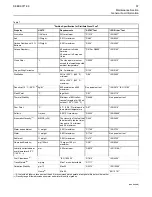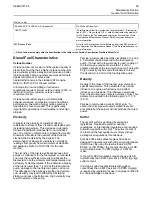
• Fill the system with new coolant.
i08273319
Fluid
Recommendations
General
Lubricant
Information
Because
of
government
regulations
regarding
the
certification
of
exhaust
emissions
from
the
engine,
the
lubricant
recommendations
must
be
followed.
• API
American Petroleum Institute
• SAE
Society Of Automotive Engineers Inc.
• ACEA
Association des Constructers
European Automobiles.
• ECF-3
Engine Crankcase Fluid
Licensing
The Engine Oil Licensing and Certification System by
the American Petroleum Institute (API) and the
Association des Constructers European Automobiles
and (ACRA) is recognized by Perkins. For detailed
information about this system, see the latest edition
of the “API publication No. 1509”. Engine oils that
bear the API symbol are authorized by API.
Illustration 61
g06183768
Typical API symbol
Terminology
Certain abbreviations follow the nomenclature of
“SAE J754”. Some classifications follow “SAE J183”
abbreviations, and some classifications follow the
“EMA Recommended Guideline on Diesel Engine
Oil”. In addition to Perkins definitions, there are other
definitions that will be of assistance in purchasing
lubricants.
Refer to Perkins Diesel Engines Fluids
Recommendations, M0113102 for additional
information that relates to oil.
Engine Oil
Commercial Oils
Perkins recommends use of Perkins Diesel Engine
Oil for all Perkins engines. Perkins unique oil
formulations have been developed to provide full
performance and maximum service life of your
engine, and in tests have been shown to provide
superior protection. Available in suitable API
classifications to meet the emissions requirements
and performance of your engine, Refer to 18 for the
correct oil specification for your engine. Consult your
Perkins distributor for more information on these
multi-grade oils.
NOTICE
Perkins require the use of the following specifica-
tion of engine oil. Failure to use the appropriate
specification of engine oil will reduce the life of
your engine. Failure to use the appropriate speci-
fication of engine oil will also reduce the life of
your aftertreatment system.
Table 18
Oil Specification
API CK-4
ACEA E9
ECF-3
API CK-4 and ACEA E9 oil categories have the
following chemical limits:
• 0.1 percent maximum sulfated ash
• 0.12 percent maximum phosphorous
• 0. 4 percent maximum sulfur
The chemical limits were developed to maintain the
expected life of the engine aftertreatment system.
The performance of the engine aftertreatment system
can be adversely affected if oil that is not specified in
table 18 is used.
The life of your Aftertreatment system is defined by
the accumulation of ash on the surface of the filter.
Ash is the inert part of the particulate matter. The
system is designed to collect this particulate matter.
There is a small percentage of particulate matter that
is left behind as the soot is burnt. This matter will
eventually block the filter, causing loss of
performance and increased fuel consumption. Most
of the ash comes from the engine oil which is
gradually consumed during normal operation. This
ash is passes through the exhaust. To meet the
designed life of the product, the use of the
appropriate engine oil is essential. The oil
specification that is listed in table 18 has low ash
content.
80
SEBU9071-06
















































